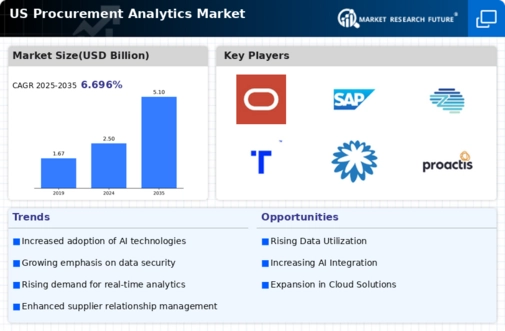Advancements in Technology
Technological advancements are playing a pivotal role in shaping the procurement analytics market. The integration of cloud computing, big data, and machine learning technologies is enhancing the capabilities of procurement analytics tools. These innovations enable organizations to analyze vast amounts of data quickly and derive actionable insights. As a result, the procurement analytics market is witnessing a shift towards more sophisticated analytics solutions that can process real-time data. This trend is expected to grow, with the market projected to reach $5 billion by 2027, indicating a robust growth trajectory driven by technological evolution.
Increased Regulatory Compliance
In the current landscape, the procurement analytics market is significantly influenced by the need for increased regulatory compliance. Organizations are compelled to adhere to various regulations, which necessitates the implementation of robust procurement analytics solutions. These tools assist in tracking compliance metrics and ensuring that procurement activities align with legal standards. For instance, the procurement analytics market is witnessing a rise in demand for solutions that facilitate compliance with federal regulations, which can lead to potential fines of up to $1 million for non-compliance. This regulatory pressure is driving organizations to invest in analytics tools that provide transparency and accountability in their procurement processes.
Rising Demand for Cost Efficiency
The procurement analytics market is experiencing a notable surge in demand for cost efficiency among organizations. As businesses strive to optimize their spending, procurement analytics tools are increasingly utilized to identify cost-saving opportunities. According to recent data, companies that leverage procurement analytics can achieve cost reductions of up to 15%. This trend is particularly pronounced in sectors such as manufacturing and retail, where margins are often tight. The procurement analytics market is thus positioned to benefit from this heightened focus on financial prudence, as organizations seek to streamline their procurement processes and enhance overall operational efficiency.
Shift Towards Data-Driven Decision Making
The procurement analytics market is witnessing a pronounced shift towards data-driven decision making. Organizations are increasingly relying on data analytics to inform their procurement strategies, moving away from traditional intuition-based approaches. This transition is supported by the growing availability of data and advanced analytics tools that provide insights into spending patterns and supplier performance. As a result, the procurement analytics market is experiencing heightened interest from businesses seeking to leverage data for strategic advantage. This trend is likely to continue, as organizations recognize the value of data in enhancing procurement efficiency and effectiveness.
Growing Emphasis on Supplier Relationship Management
The procurement analytics market is increasingly focused on enhancing supplier relationship management (SRM). Organizations recognize that effective SRM can lead to improved procurement outcomes and reduced risks. By utilizing procurement analytics tools, companies can assess supplier performance, identify potential risks, and foster stronger partnerships. This trend is particularly relevant in industries where supply chain disruptions can have significant financial implications. The procurement analytics market is thus evolving to provide solutions that facilitate better SRM, which is essential for maintaining competitive advantage in a dynamic market environment.























Leave a Comment